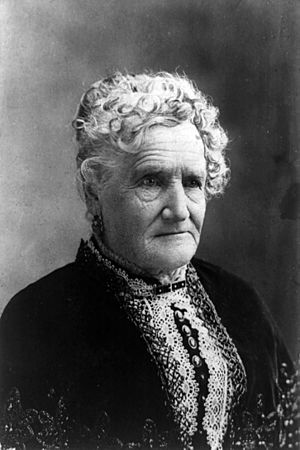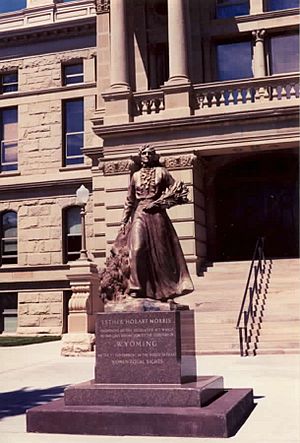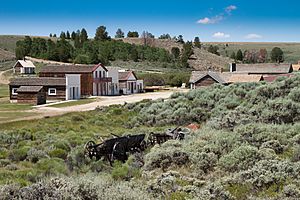Esther Hobart Morris facts for kids
Quick facts for kids
Esther Hobart Morris
|
|
|---|---|
 |
|
| Born |
Esther Hobart McQuigg
August 8, 1814 |
| Died | April 2, 1902 (aged 87) Cheyenne, Wyoming, U.S.
|
| Nationality | American |
| Occupation | Justice of the peace |
| Known for | Nation's first female judge |
| Spouse(s) |
Artemus Slack
(m. 1842–1843)John Morris
(m. 1846–1877) |
Esther Hobart Morris (born August 8, 1812 – died April 2, 1902) made history as the first woman to become a justice of the peace in the United States. A justice of the peace is like a local judge who handles small legal cases and keeps the peace. She started her job in South Pass City, Wyoming, on February 14, 1870. She served for almost nine months.
The local government in Sweetwater County chose Morris to be the justice of the peace. This happened after the previous judge, R.S. Barr, quit his job. He was protesting because Wyoming Territory had just passed a law in December 1869 that allowed women to vote. This law was called the women's suffrage amendment.
Many stories and public monuments say that Esther Morris was a big leader in getting women the right to vote in Wyoming. However, some people disagree about how much she led this effort. Esther Morris herself never took credit for the law. She said that William H. Bright, a lawmaker from South Pass City, was entirely responsible for it.
Contents
Growing Up: Esther's Early Life
Esther Hobart McQuigg was born in Spencer, New York, on August 8, 1812. She grew up in a large family. When Esther was fourteen, her mother passed away. But she continued to live with her father, grandmother, and brothers and sisters until she was 21. Then, Esther moved to Owego, New York. There, she started a business making and selling hats, which is called a millinery business.
In 1841, Esther married Artemus Slack, who was an engineer for the railroad. Sadly, her husband died in May 1843, just before her 31st birthday. Esther was upset with New York laws that stopped women from owning property. So, she moved to Illinois, where her late husband had bought some land.
In 1846, Esther Slack married John Morris in Ottawa, Illinois. They later lived in Peru, Illinois. She had a son named John in 1849. Then, she had twin sons, Robert and Edward, in 1851. Young John died when he was a toddler.
Moving West to Wyoming
In 1868, Esther's husband, John, and her oldest son, Archibald "Archy," moved to South Pass City. This area was part of Dakota Territory, but it soon became Wyoming Territory. They bought mines and worked at different jobs. They were making a home for Esther and the twins.
In 1869, Morris and her 18-year-old twin sons, Robert and Edward, traveled west to join their family. They first took a train to Bryan, a stop on the new Transcontinental Railroad. From there, Morris and her sons rode a stagecoach north. They crossed sand dunes and went up a mountain pass to the Sweetwater Mining District.
When 55-year-old Morris arrived in South Pass City, the dry, rocky land was very different from the green places she knew in Illinois and New York. Her new home was high up, at 7,500 feet. It was a tough place to live in a barren valley near the Continental Divide. The Morris family moved into a log cabin that Esther's oldest son had bought. It had a sod roof.
Winters were very harsh. People living in South Pass City, which had about 4,000 residents at one point, either left for the winter or faced being very isolated. John Morris and Archy bought parts of mining properties soon after they arrived. These included the Mountain Jack and Golden State mines.
At first, things looked good because of the gold rush. Mines and businesses in South Pass City created jobs for 2,000 workers in 1868 and 1869. But then, the gold rush ended. By 1870, most miners had left. Only about 460 people remained. By 1875, fewer than 100 people were left.
Esther Morris: A Woman Judge
Esther Morris had just settled into her new home in South Pass City. Then, in 1870, District Court Judge John W. Kingman chose her to be a justice of the peace. Morris filled out an application and provided a $500 bond, which was a promise to do the job well. The Sweetwater County Board of Commissioners approved her application on February 14, 1870. They voted two to one in her favor.
Soon after, the county clerk sent out a press release. It announced the historic news of the first woman justice of the peace. This amazing appointment was possible because Wyoming Territory had given women the right to vote in 1869.
Morris's important appointment happened after Justice R. S. Barr resigned. He quit to protest the women's suffrage law passed in December 1869. However, some records say the county board appointed Morris to finish the term of Judge J. W. Stillman. There was a challenge to her appointment, but in the end, her right to serve was confirmed.
Morris started her job as justice in South Pass City in 1870. She had to deal with Judge Stillman, who refused to give her his court records. Morris decided to drop her own case against Stillman. She ruled that she couldn't arrest him because she was involved in the case. Morris then started fresh with her own court records. She held court in the living room of her log cabin, sitting on a wooden slab.
Morris got help from her sons in the courtroom. She made Archibald her district clerk. Robert was a part-time deputy clerk. Their jobs were to keep court records and write arrest warrants. Her husband, John, was not as supportive. He was against his wife's appointment. He reportedly caused such a scene in her court that Esther had him put in jail.
Judge Morris made decisions in 27 cases during her more than eight months in office. This included nine criminal cases. None of her decisions were overturned, according to records. A few cases were appealed, but the higher court upheld her rulings. She held her justice of the peace job until her term ended on December 6, 1870. Morris wanted to be re-elected. However, neither the Republican nor the Wyoming parties chose her as a candidate.
Morris's historic time as a judge received good reviews in the South Pass News when her term ended. Her son Archy was the editor of that newspaper. However, other Wyoming newspapers did not make a big deal about it. The Wyoming Tribune in Cheyenne did mention comments from Territorial Secretary Lee. He said that the people of Sweetwater County "had not the good sense and judgment to nominate and elect her for the ensuing term."
Life After the Gold Rush
Esther Morris was a working mother. She ran a court in a town full of miners, gamblers, business owners, and other people. There were four men for every woman in South Pass City. Dealing with a rough community was hard. Her husband, John, also had a bad reputation. After her term as judge ended, Morris had him arrested for assault and battery.
More problems came for the family. In 1871, a fire destroyed the South Pass City newspaper office. It was owned by Esther Morris's son, Archibald Slack. This forced him and his wife to move to Laramie. Soon after her son left, and after a very bad winter in 1871–72, Morris left her husband and the town. Morris traveled to Laramie, where she lived with her son Archy for a short time.
However, the former judge did not stay settled. She moved to Albany, New York, and then to Springfield, Illinois, where she spent her winters. In the summers, she would return to Wyoming to visit her sons. Morris stopped moving around in the 1880s. She returned to Cheyenne to live with her son Robert.
Esther Morris was one of many people who left South Pass City. Short gold discoveries in the 1880s, 1890s, and 1930s brought miners back to the mountains. But these booms did not last long.
Esther Morris: A Champion for Women
After Wyoming gave women the right to vote in 1869, Esther Morris's appointment as the first woman justice of the peace in the United States in 1870 gained national attention. She was also the first woman to hold a judicial job in the modern world.
Morris continued to be involved in women's causes after she left the gold mines and South Pass City:
- In February 1872, she attended the American Woman Suffrage Association Convention in San Francisco.
- In August 1873, the Woman's Party of Wyoming nominated her to be a candidate for the Wyoming Territorial Legislature. Morris did not accept this nomination.
- In 1876, she served as vice president of the National American Woman Suffrage Association.
- In July 1876, she spoke at the National Suffrage Convention in Philadelphia.
- In July 1890, she presented the new Wyoming state flag to Governor Warren during the Wyoming statehood celebration.
- In 1896, she was a delegate at the 1896 Republican National Convention in St. Louis, Missouri. This convention chose William McKinley and Garret A. Hobart as candidates.
Esther Morris's Lasting Impact
Esther Hobart Morris died in Cheyenne on April 2, 1902, when she was 87 years old. She is buried at Lakeview Cemetery in Cheyenne. A simple stone with only her name marks her grave.
Since 1960, a statue of her has been one of Wyoming's two statues in the National Statuary Hall Collection at the United States Capitol in Washington, D.C. Another statue of her stands at the Wyoming State Capitol. In 2018, The New York Times wrote a belated obituary for her, recognizing her importance.
Her Role in Women's Right to Vote
Some evidence suggests that the public stories celebrating Morris's role as a suffrage leader might not be completely true. Stories about Morris hosting a big tea party for lawmakers in South Pass City, where she supposedly helped with the suffrage law, are not found in records from that time. These stories only appeared almost 50 years later.
For many years, Esther Hobart Morris has been called the "Mother of Woman Suffrage." However, the law giving women the right to vote was written a year before she became a justice of the peace. It was written by William H. Bright, a Civil War veteran from South Pass City.
Many people who were against the women's right to vote movement saw Morris's appointment as a "dangerous" sign. Some newspapers even said that more women in office would make women act in ways that were not expected. On the other side, people who supported women's right to vote often used Morris's appointment as proof that women could hold public office.
Stories About Her Impact
Some researchers today think that Morris's oldest son, who became a newspaper editor, might have helped start the stories about his mother's role. Critics say he "made it up." Other research points to Morris's friend Melville C. Brown. He was the president of the 1889 Constitutional Convention in Cheyenne. Brown claimed that she had given the suffrage bill to the legislature. Morris's son Archy Slack then wrote in the Cheyenne Sun newspaper that his mother was the "Mother of Suffrage."
The tea party story might have been forgotten if not for H.G. Nickerson. Nickerson was a lawmaker for Lander. He wrote a letter published on February 14, 1919, in the Wyoming State Journal. In it, he described the tea party and said he attended it as a candidate. This was about 50 years after the event supposedly happened.
Nickerson's story became very well known after his friend, Wyoming historian Grace Raymond Hebard, published it. She wrote about it in a 1920 pamphlet called "How Woman Suffrage Came to Wyoming (1869)." This pamphlet was given out widely. Students in public schools across the state read the story, which honored Morris's suffrage achievements. Hebard spent many years promoting the idea that Morris started and helped write Wyoming's suffrage law.
Statues Honoring Esther Morris

In 1960, Wyoming further honored Morris as a key person in Wyoming suffrage. They gave a life-sized bronze statue of her to the National Statuary Hall Collection in the rotunda of the U.S. Capitol in Washington, D.C. Important people like Vice President Richard M. Nixon were at the ceremony.
In 1963, Wyoming officials placed a copy of the same 9-foot statue at the state capitol building in Cheyenne. An inscription on it calls Morris the "Mother of Woman Suffrage." In 2006, the National Cowgirl Museum and Hall of Fame in Fort Worth, Texas, added Morris to their hall of fame. They said her "influential efforts made it possible for women to vote in the Wyoming Territory in 1869."
Esther Morris on TV
In 1960, actress Bethel Leslie played Esther Morris in an episode of the TV show Death Valley Days. The show was hosted by Stanley Andrews.
Hall of Fame Recognition
In 1973, Esther Morris was inducted into the Hall of Great Westerners at the National Cowboy & Western Heritage Museum.
See also
 In Spanish: Esther Hobart Morris para niños
In Spanish: Esther Hobart Morris para niños
- History of feminism
- List of suffragists and suffragettes
- List of women's rights activists
- Timeline of women's suffrage
- Grace Raymond Hebard
- South Pass City, Wyoming


